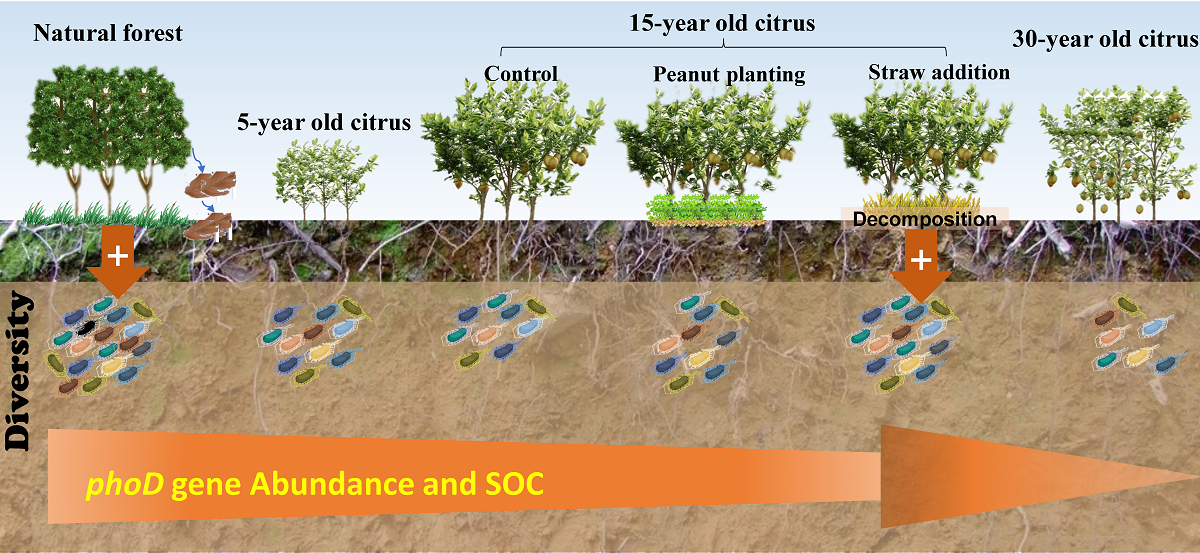南湖新闻网讯(通讯员曾全超)近日,我校资源与环境学院土壤化学与环境团队针对集约化种植导致的土壤生物多样性变化和生态调控方面研究取得系列进展,相关成果发表在Agriculture Ecosystems & Environment、Plant and Soil和Science of the Total Environment等期刊。
土壤生物作为链接地上与地下生态系统的纽带,影响着土壤养分循环、抗逆抗旱、生态系统的调控,而土壤生态系统在维持地球生态系统稳定和减缓气候变化中起重要作用,单一的、高强度集约化土地利用方式导致土壤生态系统中生物多样性下降、结构破坏、污染严重。但在经济利益的驱动下,许多林/草地仍被开发为集约化种植的果茶等园地,破坏了原有土壤生态系统的稳定,加速土壤退化进程。因此,研究高强度柑橘/茶园土壤微生物群落结构与功能有助于更好地理解集约化种植模式下土壤有机碳循环、养分平衡的驱动机制,可为有效地制定科学合理的生态调控政策和可持续发展模式提供理论依据。
针对上述科学问题,资源与环境学院土壤化学与环境团队,联合西班牙巴布罗•德奥拉维戴大学Manuel Delgado Baquerizo教授,以三峡库区不同年限的柑橘园和茶园为研究对象,探究了高强度集约化种植对土壤生态酶计量、生物多样性及功能微生物的影响。
研究表明,随着种植柑橘年限的增加,土壤中的功能微生物群落多样性与功能基因丰度均逐渐降低,尤其是与碳、磷循环相关的功能微生物表现明显。同时,土壤酸化严重是目前柑橘园与茶园的主要问题,由此抑制了微生物的生长与功能发挥,茶园土壤微生物对磷的需求随土壤pH下降而愈加强烈。而相比于土壤pH,土壤有机碳是调控柑橘园生物多样性的主控因子,外源添加秸秆、种植绿肥可有效地提高土壤肥力和增加土壤生物多样性,缓解微生物对磷的需求,因此我们提出“以碳促磷”的调控策略来提高土壤生物多样性,恢复土壤生态功能,促进集约化种植园地的可持续发展。

我校资源与环境学院博后曾全超和硕士生易杰分别为第一作者,谭文峰教授为通讯作者。该研究得到国家自然科学基金重点国际合作项目与面上项目、后三峡项目的资助。
审核人:汪明霞
【英文摘要】
Aims
The impacts associated with litter decomposition in intensive cropping on eco-enzymatic stoichiometry and microbial nutrient limitation are still under debate.
Methods
To evaluate the dynamics of carbon (C), nitrogen (N), and phosphorus (P) in response to different litter additions, we investigated the variations in soil nutrients (nitrate N, ammonium N, available P), carbon mineralization rate, soil microbial biomass, and extracellular eco-enzymatic activities (alkaline phosphatase enzyme, AP; β-1,4-glucosidase, BG; β-1,4-N-acetyl-glucosaminidase, NAG; l-leucine aminopeptidase, LAP) of soils inoculated with different orchard litters (citrus leaf and alfalfa leaf) and their mixtures in a microcosm experiment.
Results
Litter addition improved soil nutrients and microbial biomass. During the plant litter decomposition process, soil BG and AP continuously increased in the first 7 days and then decreased, while NAG and ALP reached a peak at the 14th day and then continuously reduced. Litter type was the main factor controlling eco-enzymatic activities and the ratios of eco-enzymatic activities (stoichiometry). The additions of alfalfa leaf enhanced soil nutrients and eco-enzymatic activities more than citrus leaf alone. Enzyme vector analysis revealed that soil microbial communities were co-limited by C and P during litter decomposition. Enzyme vector analysis showed that all vector angles were > 45°, suggesting that soil microorganisms were more limited by P than by N during the decomposition process. Random forest model revealed that litter type, cumulative mineralized C, and microbial biomass were the best predictor of enzyme vector angle.
Conclusions
The present study indicates that soil microbial activity (microbial biomass and enzyme activities) was sensitive to litter decomposition in orchards, and litter additions would relieve microbial nutrient limitations in orchards. Alfalfa litter played positive roles in improving soil nutrients and regulating nutrient limitation in citrus orchards, which would help manage highly intensive cropping and develop organic orchards for smart farming.
论文链接:
https://link.springer.com/article/10.1007/s11104-021-05025-5
https://www.sciencedirect.com/science/article/pii/S0167880921003911
https://www.sciencedirect.com/science/article/pii/S0048969721056321
https://www.sciencedirect.com/science/article/pii/S0167880921003832

